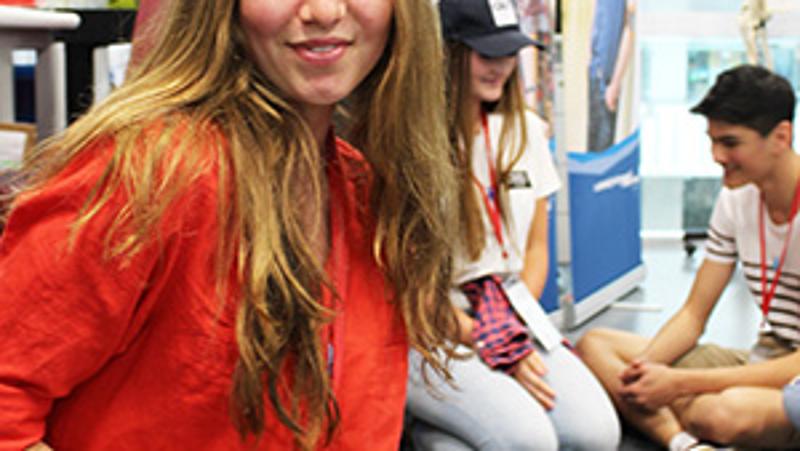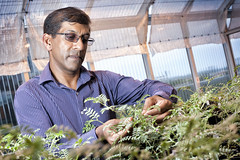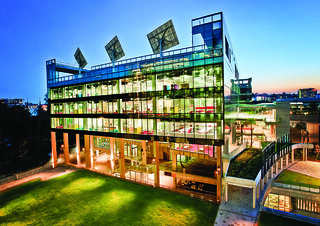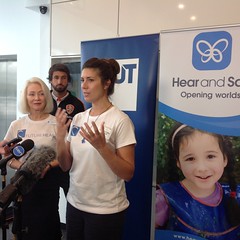
High-tech quests for the bionic ear, robot surgeons and invisibility cloaks are among the challenges that have attracted 160 of Queensland's brightest teenagers to Brisbane this week for the annual QUT Vice-Chancellor's STEM Camp.
The five-day camp for Year 11 students is taking place at the university's Gardens Point campus and utilising its advanced STEM facilities including the QUT Science and Engineering Centre (pictured) and The Cube - one of the world's largest digital interactive learning and display spaces which soars across two storeys.
The teenagers (who number 80 from regional/coastal Queensland and 80 from Brisbane) had to apply to get into the prestigious camp and tell organisers how they hoped to one day make their impact on the world in STEM (science, technology, engineering and maths).
During the camp they will tackle real-world research projects, side by side with experts.
"Each research project is a week-long challenge where teams of 16 work under the mentorship of QUT researchers and undergraduates students," said Chris Farrelly, QUT's STEM teacher-in-residence.
"Projects explore some of the major challenges and opportunities facing our society such as the next wave of advancements in nanotechnology, robotic surgery, sustainable agriculture, biofabrication and next generation virtual reality.
"Camp students also participated in a QUT Real World Futures event - The World in 10 Years - on their first day (Monday), which was led by Queensland Chief Scientist Dr Geoff Garrett and gave them a chance to hear from futurists and scientists about the advancements to come over the next 10 years."
This year's camp will conclude on Friday, September 30, with the STEM Camp Showcase Breakfast where the school students will present their research work in front of QUT Vice-Chancellor Professor Peter Coaldrake.
A video with the highlights of last year's camp can be found here.
Release date: Tuesday, September 27, 2016
Media contacts:
- Mechelle McMahon, QUT media officer, 07 3138 1150 or media@qut.edu.au
- (after hours) Rose Trapnell, QUT media team leader, 0407 585 901 or media@qut.edu.au
2016 QUT STEM CAMP FACTS:
• 160 Queensland Year 11 students
• 80 places for regional and coastal students, which include travel expenses, accommodation and meals
• 80 places for non-boarding (Brisbane) students, including meals
• Fully funded by QUT
• Boarding accommodation at Somerville House
• 10 QUT academic-led research projects
• 97 schools in total
• 48 Brisbane schools
• 32 Regional schools
• 17 Coastal and Caboolture schools
2016 VICE-CHANCELLOR'S STEM CAMP RESEARCH PROJECTS:
Biofabrication - Biomedical 3D Printing is Hear Academics (with Associate Professor Mia Woodruff, pictured)
3D printing technology is growing rapidly, as are its applications to the human way of life. The application of 3D printing to the medical industry will revolutionise the clinical treatment of serious injury, trauma and organ replacement – and change the world forever! Students will learn about advanced 3D patient scanning techniques and 3D modelling of injury sites including the morphology of the hypothetical replacement tissue constructs. They will design and optimise the internal micro-architectures of biodegradable polymer scaffold to support and guide tissue growth for a either a bone trauma case or an ear reconstruction.
Robotic Surgeons (with Dr Sean Powell)
Surgery is a task that requires high precision where errors or misjudgments can often be fatal. Recent advancements in robotics have resulted in extremely accurate robotic tools, allowing for new and greatly improved forms of surgery. In this research project, students will understand how robotic arms are constructed, their components and what they are capable of. Students will program robotic arms, incorporating computer vision techniques to identify anatomical objects and mathematical models for control in order to conduct a precision task demonstrating how precise, compact and portable a robotic surgical system can be.
The Robo-Butler Picking Challenge (with Dr Chris Lehnert)
Imagine a future where our household items were cleaned up by robot butlers or online purchases are autonomously picked from shelves and shipped by robots. In this project, students will learn how to use the Python coding language to control the movement and behaviours of the infamous dual arm Baxter robot using the vision, navigation and sensory capabilities of the robot. Students will be challenged to program the robot to detect and track household items, determine how to grasp them with a robot gripper and ultimately create a fully autonomous Robo-Butler of the future.
UAV Medical Aid Delivery Challenge Academics (with Steven Bulmer and Associate Professor Felipe Gonzalez)
Autonomous, unmanned aerial vehicles (UAV’s) are part of a fast growing area of research that is finding a variety of applications in some unexpected areas. Take the “Ambulance Drone” - by integrating a defibrillator and a basic first aid kit into a fast UAV, emergency aid can potentially be delivered far faster than traditional ambulances. In this project, students will be involved in delivering a highly sensitive medical aid package to a (simulated) remote environment. They will learn the basics of piloting quadrotors, aerial dynamics, intelligence in robotics and aerial vehicles, and will be exposed to some real research in the field. Students will design, calibrate and test their solutions, before competing in a final challenge and showcasing their work.
Invisibility Cloaks – Science Fiction or Reality? (with Dr Kristy Vernon)
Cloaking is a common theme in science fiction and fantasy genres and enables the person or object being cloaked to become invisible to the naked eye. It works on the principle that for you to see an object, light must scatter off the object and back to your eye. If you can manipulate this scattering process you could conceivably make an object appear invisible. In recent years, there has been much military interest in cloaking objects and people from visible and radio waves. This project will explore the limitations of cloaking, enabling students to design their own invisibility cloaks and fabricate nanoscale prototypes in the lab. Feeding the Future - Effects of Drought and Salinity on Legumes (with Professor Sagadevan Mundree, pictured, and Dr Peraj Karbaschi)
Feeding the Future - Effects of Drought and Salinity on Legumes (with Professor Sagadevan Mundree, pictured, and Dr Peraj Karbaschi)
Current and future food security is threatened by climate change and the ever-expanding world population. These abiotic stressors can lead to reduction and loss of crop yields, and so it is becoming increasingly important that we understand the mechanisms of the plant stress response in order to develop traits to enhance stress tolerance and to enable survival in less than ideal conditions. Students will examine the various structural, physiological and molecular parameters of the stress response in legume crops, and learn how these can be modified to ensure survival in unforgiving environments to provide a more stable food source.
Organic Electronics (with Dr Soniya Yambem)
Organic Electronics is an exciting field which uses organic materials for electrical applications. Compared to traditional inorganic electronics, organic electronics are light, flexible, cheap and easy to manufacture. This means that possibilities like flexible smart phones, wearable technologies or data glass are on the horizon. In this project, students will explore the two main fields of organic electronics which are organic solar cells and organic light emitting diodes (OLEDs). While solar cells take in light and produce electrical energy, OLEDs work in reverse by emitting light when an electrical current is passed through it. After first making their own dye sensitized solar cell from fresh berries, students will forge ahead to make their own OLEDs, exploring the process of fabricating flexible electronic devices.
Cold Case (with Dr Neil Richardson and Dr Laura Gregory)
Have you ever wondered how real the television portrayal of a crime scene investigation is? In this project students will learn the process involved from the initial recovery of human remains to biological profiling, culminating in the use of biotechnology to identify an individual via DNA analysis to solve a mock crime. Students uncover bone fragments and determine their origin using DNA samples to uncover the perpetrator of a crime and the identity of the murdered victim. They will analyse their results and present their findings to share the complex task of identifying victims of crime.
Mathematics for Imaging and Virtual Reality Academics (with Associate Professor Tomasz Bednarz and Dr Steven Psaltis)
Immersive environments, and particularly Virtual Reality (VR), are providing exciting new ways of seeing our world. In this project students will be introduced to topics such as image processing and 360-degree photography, culminating in the development of a Virtual Reality application. The project will begin with an introduction to the mathematical techniques of image processing and students will use MATLAB to manipulate and analyse scientific images. They will then be tasked with capturing real-world 360-degree images to create a Virtual Reality application in Unity3D. They will learn the mathematics required to manipulate virtual objects in three-dimensional space and apply this in their Virtual Reality application. The application will be displayed on Android devices and Google cardboard. Students will gain an understanding of the mathematics of 3D space, image processing and image analysis, and will learn how to build Virtual Reality applications such as this: http://vis.stats.technology/outputs/virtual-reality/.
Pharmacy Zombie Busters (with Dr Yasmin Antwertinger and Dr Esther Lau)
Imagine that the World Health Organisation has issued an announcement declaring the  Brisbane outbreak of the Z0-M8-1E virus to have reached epidemic levels, leaving disaster in its path. A newly discovered drug that is thought to be effective against the virus has been discovered…but it has never been used on humans. Working in teams, students will take on the role the frontline pharmacists who have been tasked with preventing the spread of this outbreak and minimising its causalities. Using expert pharmaceutical knowledge, students will firstly be challenged to create a formulation to administer this new drug to the infected. They will then be tasked to produce a zombie repellent to protect their own, the first responders and healthcare workers, who are treating the infected.
Brisbane outbreak of the Z0-M8-1E virus to have reached epidemic levels, leaving disaster in its path. A newly discovered drug that is thought to be effective against the virus has been discovered…but it has never been used on humans. Working in teams, students will take on the role the frontline pharmacists who have been tasked with preventing the spread of this outbreak and minimising its causalities. Using expert pharmaceutical knowledge, students will firstly be challenged to create a formulation to administer this new drug to the infected. They will then be tasked to produce a zombie repellent to protect their own, the first responders and healthcare workers, who are treating the infected.






